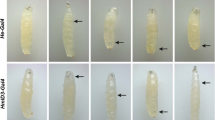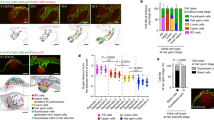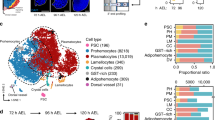Abstract
The Drosophila melanogaster lymph gland is a haematopoietic organ1,2,3 in which pluripotent blood cell progenitors proliferate and mature into differentiated haemocytes. Previous work4 has defined three domains, the medullary zone, the cortical zone and the posterior signalling centre (PSC), within the developing third-instar lymph gland. The medullary zone is populated by a core of undifferentiated, slowly cycling progenitor cells, whereas mature haemocytes comprising plasmatocytes, crystal cells and lamellocytes are peripherally located in the cortical zone. The PSC comprises a third region that was first defined as a small group of cells expressing the Notch ligand Serrate5. Here we show that the PSC is specified early in the embryo by the homeotic gene Antennapedia (Antp) and expresses the signalling molecule Hedgehog. In the absence of the PSC or the Hedgehog signal, the precursor population of the medullary zone is lost because cells differentiate prematurely. We conclude that the PSC functions as a haematopoietic niche that is essential for the maintenance of blood cell precursors in Drosophila. Identification of this system allows the opportunity for genetic manipulation and direct in vivo imaging of a haematopoietic niche interacting with blood precursors.
This is a preview of subscription content, access via your institution
Access options
Subscribe to this journal
Receive 51 print issues and online access
$199.00 per year
only $3.90 per issue
Buy this article
- Purchase on Springer Link
- Instant access to full article PDF
Prices may be subject to local taxes which are calculated during checkout




Similar content being viewed by others
References
Rizki, T. M. The circulatory system and associated cells and tissues. In The Genetics and Biology of Drosophila (eds Ashburner, M. and Wright, T. R. F.) 397–452 (Academic Press, London, 1978)
el Shatoury, H. H. The structure of the lymph gland of Drosophila larvae. Roux Arch. EntwMech. Organ. 147, 489–495 (1955)
Evans, C. J. Hartenstein, V. & Banerjee, U. Thicker than blood: conserved mechanisms in Drosophila and vertebrate hematopoiesis. Dev. Cell 5, 673–690 (2003)
Jung, S. H., Evans, C. J., Uemura, C. & Banerjee, U. The Drosophila lymph gland as a developmental model of hematopoiesis. Development 132, 2521–2533 (2005)
Lebestky, T., Jung, S. H. & Banerjee, U. A Serrate-expressing signaling center controls Drosophila hematopoiesis. Genes Dev. 17, 348–353 (2003)
Mandal, L., Banerjee, U. & Hartenstein, V. Evidence for a fruit fly hemangioblast and similarities between lymph-gland hematopoiesis in fruit fly and mammal aorta-gonadal-mesonephros mesoderm. Nature Genet. 36, 1019–1023 (2004)
Lo, P. C., Skeath, J. B., Gajewski, K., Schulz, R. A. & Frasch, M. Homeotic genes autonomously specify the anteroposterior subdivision of the Drosophila dorsal vessel into aorta and heart. Dev. Biol. 251, 307–319 (2002)
Ryan, K. M., Hoshizaki, D. K. & Cripps, R. M. Homeotic selector genes control the patterning of seven-up expressing cells in the Drosophila dorsal vessel. Mech. Dev. 122, 1023–1033 (2005)
Crozatier, M., Ubeda, J. M., Vincent, A. & Meister, M. Cellular immune response to parasitization in Drosophila requires the EBF orthologue collier. PLoS Biol. 8, E196 (2004)
Casares, F. & Mann, R. S. The ground state of the ventral appendage in Drosophila. Science 293, 1477–1480 (2001)
Hisa, T. et al. Hematopoietic, angiogenic and eye defects in Meis1 mutant animals. EMBO J 23, 450–459 (2004)
Azcoitia, V., Aracil, M., Martinez, A. C. & Torres, M. The homeodomain protein Meis1 is essential for definitive hematopoiesis and vascular patterning in the mouse embryo. Dev. Biol. 280, 307–320 (2005)
Schnabel, C. A., Jacobs, Y. & Cleary, M. L. HoxA9-mediated immortalization of myeloid progenitors requires functional interactions with TALE cofactors Pbx and Meis. Oncogene 19, 608–616 (2000)
Scadden, D. T. The stem-cell niche as an entity of action. Nature 441, 1075–1079 (2006)
Song, X., Zhu, C. H., Doan, C. & Xie, T. Germline stem cells anchored by adherens junctions in the Drosophila ovary niches. Science 296, 1855–1857 (2002)
Kimble, J. & Crittenden, S. L. Germline proliferation and its control. In WormBook (eds The C. elegans Research Community), doi/10.1895/wormbook.1.13.1 (15 August, 2005)
Spradling, A., Drummond-Barbosa, D. & Kai, T. Stem cells find their niche. Nature 414, 98–104 (2001)
Calvi, L. M. et al. Osteoblastic cells regulate the haematopoietic stem cell niche. Nature 425, 841–846 (2003)
Zhang, J. et al. Identification of the haematopoietic stem cell niche and control of the niche size. Nature 425, 836–841 (2003)
Yamashita, Y. M., Fuller, M. T. & Jones, D. L. Signaling in stem cell niches: lessons from the Drosophila germline. J. Cell Sci. 118, 665–672 (2005)
Tumbar, T. et al. Defining the epithelial stem cell niche in skin. Science 303, 359–363 (2004)
Abbott, M. K. & Kauffman, T. C. The relationship between the functional complexity and the molecular organization of Antennapedia locus of Drosophila melanogaster. Genetics 114, 919–942 (1986)
Lum, L. & Beachy, P. A. The Hedgehog response network: sensors, switches, and routers. Science 304, 1755–1759 (2004)
Chuang, P. T. & Kornberg, T. B. On the range of hh signaling. Curr. Opin. Genet. Dev. 10, 515–522 (2002)
Crittenden, S. L., Leonhard, K. A., Byrd, D. T. & Kimble, J. Cellular analyses of the mitotic region in the Caenorhabditis elegans adult germ line. Mol. Biol. Cell 17, 3051–3061 (2006)
Abramovich, C. & Humphries, R. K. Hox regulation of normal and leukemic hematopoietic stem cells. Curr. Opin. Hematol. 12, 210–216 (2005)
Kieusseian, A. et al. Expression of Pitx2 in stromal cells is required for normal hematopoiesis. Blood 107, 492–500 (2006)
Zhang, Y. & Kalderon, D. Hedgehog acts as a somatic stem cell factor in the Drosophila ovary. Nature 410, 599–604 (2001)
Gering, M. & Patient, R. Hedgehog signaling is required for adult blood stem cell formation in zebrafish embryos. Dev. Cell 8, 389–400 (2005)
Bhardwaj, G. et al. Sonic hedgehog induces the proliferation of primitive human hematopoietic cells via BMP regulation. Nature Immunol. 2, 172–180 (2001)
Acknowledgements
We thank R. Cripps for drawing our attention to Antennapedia expression in the developing cardiogenic mesoderm. We thank M. Crozatier, M. Meister and A. Vincent for useful discussions. We thank all members of the Banerjee and Hartenstein laboratories for their helpful comments and suggestions. In particular, we thank S. A. Sinenko for assistance with immunohistochemistry and S.-H. Jung for her initial experiments on Hedgehog. We appreciate the help of all those who provided us with reagents: W. Gehring, S. M. Cohen, L. Cooley, K. Moses, M. Crozatier, S. Noselli, A. Salzberg, H. Müller, I. Ando, K. Basler and R. Holmgren. This work was supported by an NIH grant to U.B. and V.H., and by NIH training grant support to J.A.M.-A. and C.J.E.
Author information
Authors and Affiliations
Corresponding author
Ethics declarations
Competing interests
Reprints and permissions information is available at www.nature.com/reprints. The authors declare no competing financial interests.
Rights and permissions
About this article
Cite this article
Mandal, L., Martinez-Agosto, J., Evans, C. et al. A Hedgehog- and Antennapedia-dependent niche maintains Drosophila haematopoietic precursors. Nature 446, 320–324 (2007). https://doi.org/10.1038/nature05585
Received:
Accepted:
Issue Date:
DOI: https://doi.org/10.1038/nature05585
This article is cited by
-
Drosophila Hox genes induce melanized pseudo-tumors when misexpressed in hemocytes
Scientific Reports (2021)
-
Single-cell transcriptome maps of myeloid blood cell lineages in Drosophila
Nature Communications (2020)
-
Molecular control of the female germline stem cell niche size in Drosophila
Cellular and Molecular Life Sciences (2019)
-
Jumu is required for circulating hemocyte differentiation and phagocytosis in Drosophila
Cell Communication and Signaling (2018)
-
Systemic control of immune cell development by integrated carbon dioxide and hypoxia chemosensation in Drosophila
Nature Communications (2018)
Comments
By submitting a comment you agree to abide by our Terms and Community Guidelines. If you find something abusive or that does not comply with our terms or guidelines please flag it as inappropriate.



